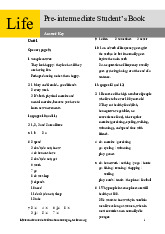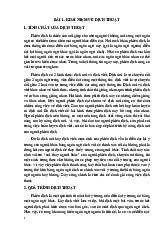




Preview text:
LESSON PLAN
TIẾNG ANH 11 FRIENDS GLOBAL UNIT 4: HOME
LESSON 4D – GRAMMAR: IMAGINARY SITUATIONS I. OBJECTIVES
By the end of this lesson, Ss will be able to: 1. Knowledge
- Understand and identify the structure and usage of the second conditional.
- Recognize and use the expressions "I wish ..." and "if only ..." to express desires and regrets. 2. Competences
- Formulate and construct sentences using the second conditional, "I wish ..." and "if only ..." accurately.
- Apply the structures in talking about hypotheses. 3. Personal qualities
- Be more aware of changes in the far future.
- Be collaborative and supportive in pair work and teamwork.
- Actively join in class activities. II. MATERIALS
- Grade 11 textbook, Unit 4, Grammar
- Computer connected to the Internet - Projector / TV/ mini boards - PowerPoint Unit 4D III. PROCEDURES
1. ACTIVITY 1: LEAD-IN (10 mins) a. Objectives:
- Get students' attention at the beginning of the class.
- Students can gain more confidence and interest in the lesson.
- Ss can review the grammar of the previous lesson. b. Content: - Fantasy Home Quest - Exercises 1 and 2. c. Products:
- Students discuss with their friends. d. Organisation
TEACHER’S AND STUDENTS’ ACTIVITIES CONTENT
Fantasy Home Quest + Exercise 1 (5 mins)
- T checks the meaning of stately home (a large old Ideas from students
house that has historical interest and can be visited by the public).
- Students read the fact file.
- T elicits all the good points of living in such a house
by asking Ss to give some adjectives and nouns
referring to its features, characteristics and amenities.
- Ss get into small groups of 5, and create a wish list for their dream house.
- Ss compare their dream house and the stately home, using the comparative form.
- T asks a few students to share their ideas with the class.
- T transitions the discussion towards the target
grammar point by linking their wishes for their dream
houses with the concept of imaginary situations.
Exercise 2: Read and listen to the dialogue. What two outdoor and indoor changes do the speakers mention? (5 mins)
- T goes through the instructions. (Possible answers)
- T plays recording 2.09 for students to read and listen
removing trees to make room for a
and make a note of the changes.
swimming pool; taking away statues … to
- T checks the answers as a class. build a bowling alley
- T asks: Do you agree with the changes mentioned?
- T elicits a few answers. e. Assessment
- Teacher observes the groups and discussion.
- T gives feedback to group answers and individual answers.
2. ACTIVITY 2: THE SECOND CONDITIONAL (11 mins) a. Objectives:
- Ss get used to the forms and uses. b. Content: - Exercises 3 and 4. c. Products:
- Students complete exercises in their books. d. Organisation
TEACHER’S AND STUDENTS’ ACTIVITIES CONTENT
Presentation: Exercise 3. Read the Learn this! box and complete it. Underline all the examples of
the second conditional in the dialogue. (2 mins)
- T asks students to read the Learn this! box and KEY complete the rule.
1. past simple 2. would/ could
- Students look for examples of the second But if it were my house, I wouldn’t allow people to
conditional in the dialogue. visit.
- T checks answers as a class..
If you had a party, you could invite hundreds of people!
The parties would be better if I made a few
changes, though. Well, if those trees weren’t there,
there’d be room for a swimming pool! If you took
away all the statues, you could build a great bowling alley there!
Practice: Exercise 4. Complete these second conditional sentences using the verbs in brackets. (9 mins)
- Students complete the sentences. Answer key:
- T checks the answers as a class. 1. lived; would have 2. visited; would sleep 3. could; was 4. wasn’t; would watch e. Assessment
- Teacher observation on Ss’ performance.
- Teacher’s feedback and peers’ feedback.
3. ACTIVITY 3: WISH and IF ONLY (12 mins) a. Objectives:
- Ss get used to the forms and uses. b. Content: - Exercises 5 and 6. c. Products:
- Students complete exercises in their books. d. Organisation
TEACHER’S AND STUDENTS’ ACTIVITIES CONTENT
Presentation: Exercise 5. Read the Learn this! box and complete it. Underline one example of I
wish … and one example of If only … in the dialogue. (3 mins)
- T goes through rule a in the Learn this! box, asks Answer key:
students to find examples of I wish … and if only 1. had 2. lived
…in the dialogue in exercise 2. 3. wouldn’t 4. would Examples in the dialogue:
- T elicits the tense of the verbs following the two I wish I lived here.
phrases (the past simple).
If only I were a member of the Howard family!
- Ss complete the box. T checks answers as a class.
Practice: Exercise 6. Complete the first line of each mini-dialogue with the verbs in brackets. Use
the past simple or would / could + infinitive without to. Complete the other lines with the second conditional. (9 mins)
- T goes through the Look out! box. Point out that Answer key:
although we often use were instead of was in 1. would come
second conditional sentences and with if only and I 2. would give
wish, was is equally correct. Were sounds slightly 3. was / were
more formal, but it is also used in informal English. 4. lived
- Students complete the sentences. 5. was / were
- T checks answers as a class. 6. would get e. Assessment
- Teacher observation on Ss’ performance.
- Teacher’s feedback and peers’ feedback.
4. ACTIVITY 4: PRODUCTION (10 mins) a. Objectives:
- Ss can use the second conditional in their speech.
- Ss can talk about hypothetical situations. b. Content: - Exercise 7. c. Products:
- Students take notes in their books, discuss with their friends, then report. d. Organisation
TEACHER’S AND STUDENTS’ ACTIVITIES CONTENT
Exercise 7 (Speaking). In pairs, talk about what you would do if you? (10 mins)
- T goes through the instructions and give students
two minutes to think of two sentences for each of the points.
- In pairs, students compare their ideas.
- T circulates and monitors, making a note of any
errors you hear. When Ss have finished, T writes
the errors on the board without saying who made
them. Students can correct the mistakes as a class.
- A few students volunteer to share their ideas with the class. e. Assessment
- Teacher observation on Ss’ performance.
- Teacher’s feedback and peers’ feedback. 4. CONSOLIDATION (2 mins) a. Wrap-up
- If T is using the Classroom Presentation Tool, first do the lesson closer to review what has been covered in this lesson.
- T asks students: What have you learned today? What can you do now? and elicits answers: I
can use the second conditional, ‘I wish …’ and ‘if only …’ to talk about imaginary situations. b. Homework
- Prepare for the next lesson




